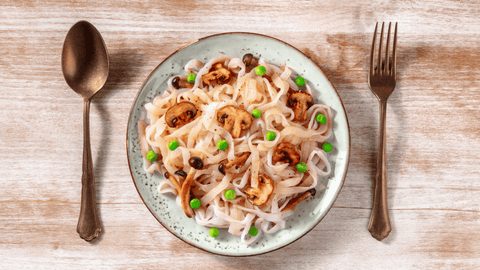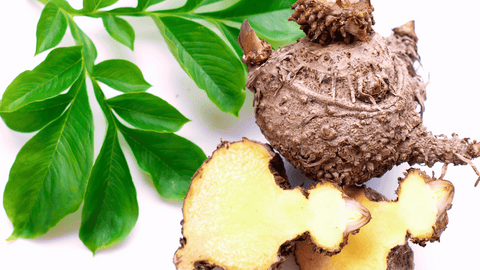Recipe

What is Konjac? Its Benefits, Side Effects and Uses
What Is Konjac?
Konjac and konnyaku are popular names for Amorphophallus Konjac, a vegetable species endemic to Yunnan in southwest China with an edible corm. It's also called konjaku, konnyaku potato, devil's tongue, or elephant yam. Konjac contains glucomannan, a fibre commonly used in weight loss products.
It grows in mild subtropical to tropical regions of East and Southeast Asia, from China and Japan to Indonesia and Vietnam. It is a perennial plant with huge corms that can reach 25 cm (10 in) in diameter. Its starchy (bulb-like) "corm" is used to generate nutritious noodles and grain replacements like cauliflower rice.
This plant's corm-based cuisine, known in English as konnyaku, is largely prepared and consumed in China, Japan, and Korea. While some studies, such as those published in Obesity Treatment 2020, show potential benefits, further research is needed to determine its benefits for weight loss.
What is Konjac Glucomannan
Konjac has its secret weapon, and that is known as glucomannan (pronounced gloo-ko-man-nan). Konjac glucomannan is a natural thickening agent and source of fibre that may help with weight management by promoting feelings of fullness.
Ever heard of konjac?
Konjac may not be well-known, but this interesting root vegetable has been a dietary staple in East Asia for generations. It is a natural, fibre-rich alternative to rice and noodles! It is widely produced, mainly in Japan, China and Indonesia. It is also used to make Konjac flour and jelly, which is a vegan alternative to gelato! These flours are combined to make konnyaku cake, which is the secret ingredient in those delicious shirataki noodles you may have had in a Japanese restaurant, so consider Konjac the next time you are looking for something different and healthy.
While Konjac is a natural substance, be aware of weight loss medication that contains it. Some supplements may contain hidden and possibly hazardous substances. Because nutritional supplements are not as closely controlled as drugs, search for items that have been certified by trustworthy organisations to assure their safety and quality.

What are the benefits of Konjac?
Ever wonder what makes Konjac so filling? Let's explore the surprising benefits of Konjac:
Skin Health
A 2013 research discovered that Konjac can improve skin health and reduce acne. It is said to speed up wound healing and minimize allergic responses. Also, Konjac sponges are an excellent beauty product for cleaning your face from everyday dirt and grime.
Weight loss
Fibre adds richness. Consuming it regularly keeps you feeling fuller for longer, minimising your urge to overeat or snack between meals. Konjac also expands in the stomach, which helps you feel full. According to a 2005 survey, a 1,200-calorie diet that contained a glucomannan fibre supplement resulted in more weight reduction than a 1,200-calorie diet with a placebo.
Increased immunity
The Konjac plant's antibacterial and antioxidant properties are thought to boost immunity. Your body may be able to combat common infections like the cold and flu more efficiently.
Oral health benefits
Because the Konjac plant includes antibacterial qualities, it helps alleviate minor oral health issues like toothaches. The Konjac plant can help clean your teeth and combat germs.
Improves digestion
Konjac is water soluble, which improves digestion. It can help strengthen your digestive system, making it an excellent natural cure for anyone with digestive issues. It may also help with constipation and hemorrhoids.
Helps regulate diabetes
Konjac contains glucomannan, which is beneficial for managing blood sugar levels in the body, thereby assisting in the management and treatment of diabetes.
What does it taste like?
The topic of what Konjac tastes like is both humorous and intriguing. According to most reports, when eaten alone, it does not taste like much. While it has a somewhat grassy and oceany fragrance, this does not typically convert into flavour when cooked. It has a slight tinge of salt, but it's quite mild, making it a blank slate.
Its gelatinous porous nature, paired with its neutrality, allows it to absorb the tastes of whatever it is cooked with, making it a culinary chameleon. And, being a low-carb, gluten-free vegetable, it is ideal for a variety of dietary demands. It is a popular supplement for individuals following keto, paleo, or low-glycemic diets. Glucomannan, extracted from Konjac root and a popular ingredient in Konjac -based low calorie foods, is a water-soluble dietary fibre derived from dehydrated Konjac and has much higher viscidity than other related additions when used in equal doses. This implies that it may thicken and emulsify a food product without adding any taste.

On the other hand, Konjac pasta, such as our slim variety, is popular because they have the same texture and bite as regular spaghetti. Its neutral flavour compliments a variety of pasta dishes, adding a good twist to any meal. Additionally, its gluten-free nature makes it attractive to people with gluten intolerance and celiac disease, providing a safer alternative.
What are the Side Effects of Konjac?
Even the healthiest foods can have downsides. Let's explore the potential Konjac side effects of Konjac to ensure you make informed choices about including it in your diet.
- Glucomannan is typically well tolerated. However, like with any high-fibre product, it might induce digestive issues, such as Bloating, diarrhoea, or loose stools. The Symptoms may include stomach discomfort, gas, and nausea.
- According to the FDA, certain Konjac sweets have resulted in choking fatalities among elderly persons and children. This caused the FDA to issue an import notice for Konjac candy.
- Konjac candies have a gelatinous composition that does not dissolve in the tongue, unlike other gelatin products.
- Konjac supplements can cause obstruction in the oesophagus or bowel, especially if taken in tablets, without water, older, or with swallowing issues.
- Konjac jelly has been prohibited in some countries due to the significant risk of bowel or throat blockage. Konjac supplements are not recommended for children, pregnant women, or those who are nursing.
- If you experience symptoms of an allergic reaction, such as difficulty breathing, hives or rash, itchy skin, rapid heart rate, and swelling, stop taking Konjac.
- Konjac has been proven to reduce blood sugar levels. It may reduce sugar absorption; thus, people with diabetes should regularly check their blood sugar levels. If you are on insulin or other diabetic treatments, consult your doctor before consuming Konjac.

How to use Konjac
A low-calorie option among snacks that are also high in calories would be Eat Water’s Slim Noodles. These noodles can add extra health benefits to your diet instead of using regular noodles. Konjac powder works like magic in baked goods and sauces; They have a smooth texture and add a lot of nutrients.
For mastering a low-calorie meal, take Konjac with lots of water, ideally before your meal. There is no recommended or standardised dosage of Konjac . The amount of Konjac you should take depends on the producer and why you're utilising it. Always remember to follow the instructions provided on the package or consult with a doctor for personalised guidance.
Conclusion
In conclusion, Konjac has several health benefits, such as weight control, improved skin health and digestion. Although, it’s important to consume it properly as it has some side effects which cannot be ignored. Konjac is a versatile ingredient and has endless potential, making it a viable option for those looking for a healthier diet. Eat water offers premium Konjac-based products, giving priority to quality and safety. Don’t wait and introduce Konjac into your diet with care; you may get its advantages while eating tasty and healthy meals.
Frequently Asked Questions
Q: Are Konjac Noodles and Konjac Pasta healthy?
A: Yes, Konjac Noodles and Konjac Pasta are often considered health choices. They're low in calories and carbs, making them ideal for weight control or low-carb diets. They're also high in fibre, which can help you to improve intestinal health and make you feel full.
Q: What does Konjac do to the body?
A: Konjac provides various health benefits to the body. For example Konjac products y may reduce blood sugar and cholesterol levels, enhance skin and intestinal health, aid in wound healing, and encourage weight reduction.
Q: Can you lose weight using Konjac ?
A: Glucomannan extracts from Konjac roots include water-soluble fibre. It aids weight reduction in obese or overweight persons.
Q: What is Konjac Flour?
A: 'Konjac Flour', is made from the crushed root of the Konjac plant, which grows in various East Asian nations. It is high in fibre and has thickening characteristics, making it an adaptable ingredient for gluten-free baking and cooking.
Q: What is Konjac Rice?
A: Konjac Rice is made from the Konjac plant, a root vegetable that contains 97% water and 3% fibre. It has a bouncy, jelly-like feel. Konjac rice is a fantastic diet meal since it comprises 5 grams of calories and 2 grams of carbohydrates and has no sugar, fat, or protein.
